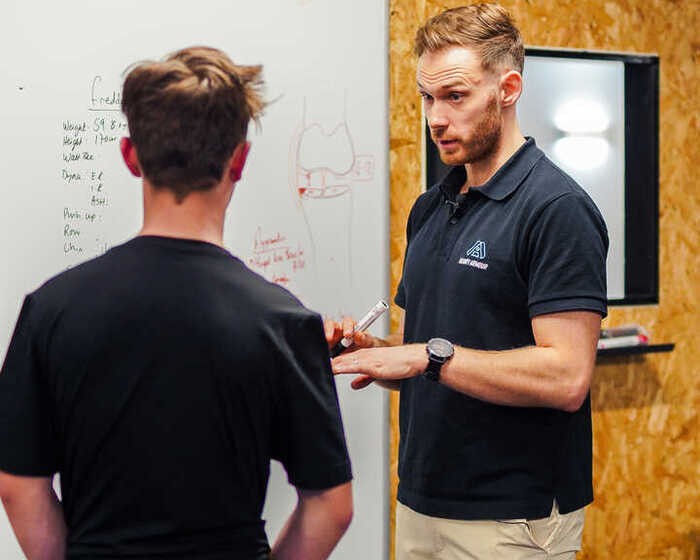The Crucial First Four Weeks
Post-Op ACL Reconstruction
Goals, importance, and what to expect
ACL (anterior cruciate ligament) reconstruction surgery is a big step toward recovery and getting back to full mobility/sport. But the surgery is only the beginning; the recovery process, especially the first-month post-op, is critical. This early period lays the foundation for long-term stability, mobility, and success.
Here’s a breakdown of the aims and importance of those crucial first four weeks after ACL surgery and what to expect during this early phase.
Why the First 4 Weeks Matter
The first-month post-surgery is all about setting the stage for optimal healing. In these four weeks, your body is adapting to the repaired ligament, and the groundwork for muscle memory, mobility, and strength is being established. Skipping steps or pushing too hard during this phase can slow down recovery, but following protocols and taking it step-by-step will make the entire process smoother.
Key Aims of the First 4 Weeks
1. Control Pain and Swelling
Why It Matters: Pain and swelling are your body’s natural responses to surgery, but excessive inflammation can hinder healing and make movement difficult. Managing swelling prevents joint stiffness, muscle shutdown (especially in the quadriceps), and improves range of motion.
How It’s Done: Use ice packs, compression, and elevation consistently, as instructed by your physical therapist or surgeon. Pain management, including prescribed medications, can also help keep pain levels manageable, allowing for better participation in early rehabilitation.
2. Achieve Full Knee Extension
Why It Matters: Regaining full knee extension (ability to straighten the knee) is one of the most important early goals in ACL recovery. Failure to achieve it early can lead to abnormal walking patterns and long-term issues with knee function.
How It’s Done: Passive stretching exercises, quad sets (tightening the thigh muscle with the knee straight), and practising heel props can help. Injury armour will guide you in safe and effective ways to encourage knee extension without putting stress on the new ACL.

3. Gradual Improvement in Range of Motion (ROM)
Why It Matters: While full range of motion isn’t expected immediately, increasing it over time prevents stiffness, improves flexibility, and supports the joint’s stability. A limited ROM can hinder daily activities and increase the risk of future injury.
How It’s Done: Gentle, controlled bending (flexion) and straightening (extension) exercises are introduced. Progress may be slow, and you might feel tightness, but working through this with consistent, guided movements is essential. By the end of the first four weeks, aiming for about 90 degrees of knee flexion is often the goal, though this can vary.
4. Reactivation of Quadriceps Muscles
Why It Matters: After ACL surgery, the quadriceps muscles can quickly weaken and “shut down.” Reactivating these muscles early helps improve knee stability and control, crucial for walking and movement down the road.
How It’s Done: Simple isometric exercises, such as quad sets and straight-leg raises, are typically introduced in the first-week post-surgery. Electrical stimulation may also be used under your guidance at Injury Armour to help re-engage the quadriceps and reduce atrophy.
5. Encourage Normal Walking Patterns
Why It Matters: Many patients compensate for pain or discomfort by adopting an altered gait, which can lead to hip, back, and knee issues. Re-learning a proper walking pattern from the start helps with balance, coordination, and joint alignment, ultimately speeding up recovery.
How It’s Done: Using crutches and braces initially allows for partial weight-bearing, and as strength and stability improve, you’ll gradually progress to full weight-bearing. Focusing on heel-to-toe walking and avoiding a limp are encouraged once your therapist approves.

The Importance of Patience and Adherence
Recovery from ACL surgery is not a race, and the first four weeks require a lot of patience and dedication. Rushing through exercises, ignoring pain, or not following professional guidance can increase the risk of re-injury and complications.
For instance, an overly aggressive approach might stress the graft, while inactivity can lead to stiffness and muscle loss. Consistency with prescribed exercises, regular physical therapy sessions, and adhering to movement restrictions are the keys to a successful recovery journey.
Psychological Benefits of Focusing on Early Goals
The emotional and mental aspects of recovery play a significant role in the physical healing process. Working toward manageable goals like pain control, achieving knee extension, and gentle range of motion increases confidence, reduces anxiety, and keeps you motivated. Seeing progress, even if it’s slow, helps maintain a positive outlook, which is essential in long recovery processes like ACL rehabilitation.

What to Expect in Physio Sessions
During the first four weeks, your physio sessions will be focused on:
- Learning gentle stretches and exercises.
- Monitoring your form and technique to ensure safe movements.
- Gradually increasing activity levels based on your body’s responses.
- Regular assessments to ensure you’re on track with the key goals of each phase.
Injury Armour will also be a key source of support, answering questions and adjusting your program based on your progress. Remember, every person’s body responds differently, and your path to recovery may look different from someone else’s.
How can we help?
The first four weeks post-ACL surgery are a unique period of healing, progress and patience. Focusing on the key goals of controlling pain and swelling, achieving knee extension, increasing range of motion, reactivating the quadriceps, and learning proper walking patterns will set you up for a successful recovery.
By following the program and working closely with Injury Armour, you’ll build a strong foundation for the more intensive phases of ACL rehabilitation to come.
Posted by Jason Pope on November 15th 2024
